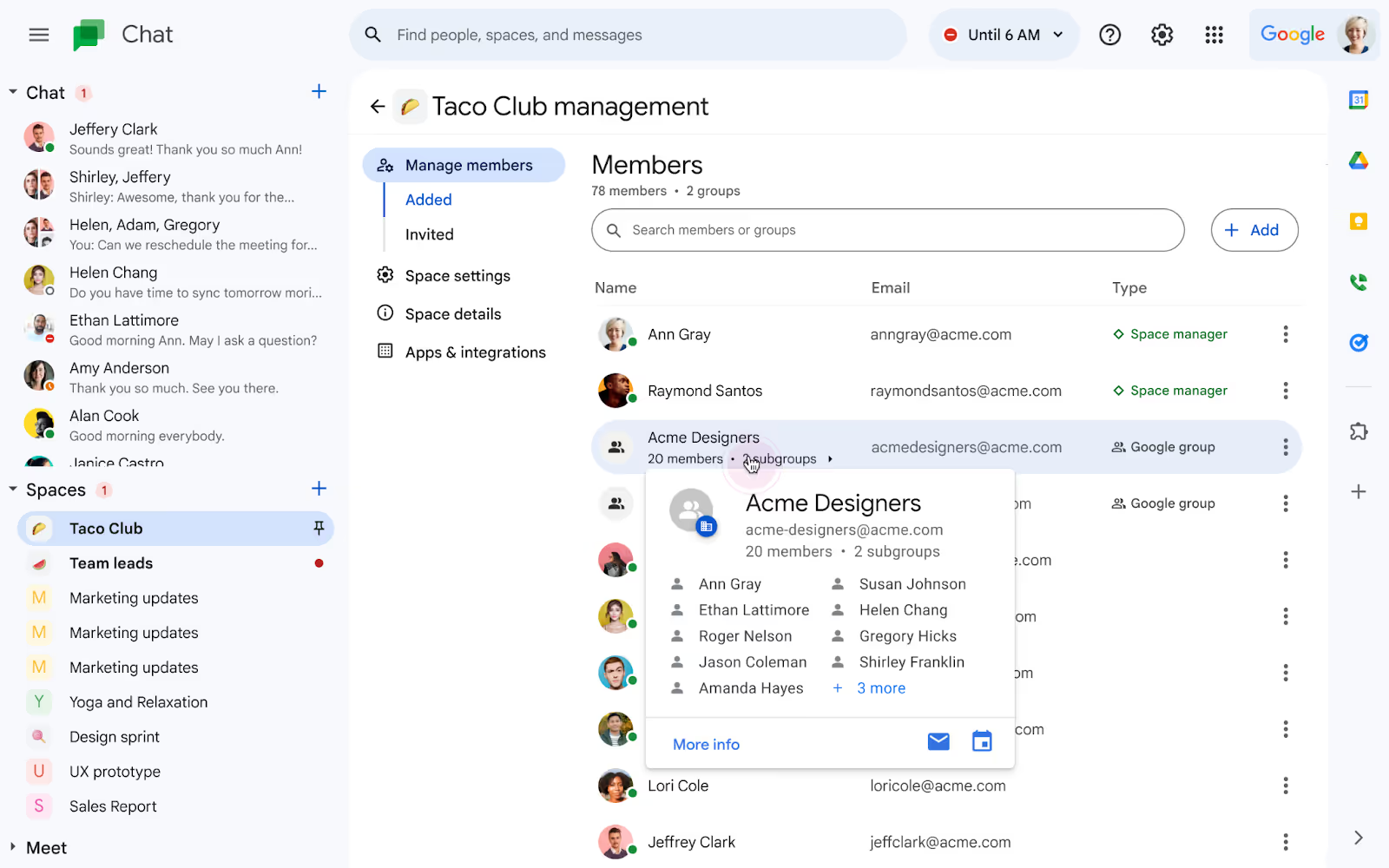Étant donné que de nombreux employés du service client travaillent de manière indépendante au sein de leur département, la collaboration peut ne pas sembler être une fonction que les membres de l'équipe considéreraient comme avantageuse. Bien que le travail indépendant reste indispensable, une équipe de service client collaborative peut produire des expériences clients plus durables que les automatismes ou les opérateurs indépendants.
Cet article explique l'importance de la collaboration entre les membres de l'équipe du service client et explique comment une solution de boîte de réception partagée peut contribuer à améliorer la productivité de l'équipe.
Les équipes du service client aujourd'hui
Automatisation et l'IA sont de plus en plus courantes dans le paysage commercial numérique, et les services clients ne font pas exception. Les clients d'aujourd'hui reçoivent des réponses instantanées grâce aux avancées technologiques telles que les chatbots et les réponses automatisées par téléphone ou par e-mail. Pour certaines organisations, les règles d'automatisation sont suffisantes pour garantir des expériences de service client positives. Les questions plus complexes nécessitent toutefois une intervention humaine pour produire des résultats personnalisés de meilleure qualité.
Ces dernières années ont radicalement changé la façon dont les clients interagissent avec les entreprises, la pandémie de COVID-19 ayant encouragé le remplacement des contacts personnels potentiellement contagieux par des rencontres en ligne. Par conséquent, les clients attendent davantage de leur expérience de service client, ce qui incite les équipes à mettre en œuvre à la fois l'intervention humaine et l'automatisation pour fournir une assistance rapide et de haute qualité. Les marques qui s'appuient principalement sur les canaux en ligne pour répondre à la majeure partie des service à la clientèle les demandes exigent que les équipes s'assurent que chaque interaction numérique répond aux normes les plus élevées possibles.
Pour de nombreux clients, une seule mauvaise interaction peut modifier leur fidélité à la marque. Pour d'autres, une mauvaise interaction peut être excusable si elle est bien gérée. Il est important de savoir que toutes les interactions avec les clients ne seront pas positives, mais l'utilisation des bons outils pour résoudre les problèmes peut aider à fidéliser les clients et à renforcer la réputation de fiabilité de votre marque.
La nécessité du courrier électronique du service client
Comme de nombreux représentants du service client travaillent à distance depuis leur domicile, ils s'appuient sur des canaux de communication numériques tels que les applications de messagerie instantanée, les appels vidéo Zoom et les interactions téléphoniques. Bien que ces outils puissent être très efficaces, le courrier électronique reste la référence absolue en matière de communications professionnelles.
La plupart des consommateurs citent la rapidité et la qualité des réponses du service client comme leurs principales priorités, ce qui signifie que les équipes ont besoin d'une plateforme numérique capable de fournir les deux. Le courrier électronique offre un système organisé permettant une intervention à la fois automatisée et humaine. Les équipes peuvent répondre aux e-mails individuellement pour une touche personnalisée ou définir des règles d'automatisation pour améliorer les temps de réponse et observer bonnes pratiques en matière de gestion des e-mails.
Par exemple, une grande entreprise peut utiliser des modèles d'e-mail pour rédiger des réponses personnalisées si le volume de la boîte de réception de son service client est élevé. Les modèles permettent aux agents d'envoyer des réponses personnalisées aux clients, conformes aux politiques et aux valeurs de l'entreprise. Le fait de placer les tâches fastidieuses telles que les suivis sur le pilote automatique augmente la productivité en permettant aux membres de l'équipe de se concentrer sur d'autres responsabilités nécessitant une intervention humaine.
Il est donc essentiel que les équipes trouvent une plateforme permettant aux membres de travailler ensemble pour élaborer des réponses pertinentes et définir des règles d'automatisation pour accélérer le flux de travail. Cependant, la plupart des solutions de messagerie traditionnelles n'offrent que des fonctions collaboratives limitées, et les équipes d'aujourd'hui ont besoin d'un soutien supplémentaire. La recherche d'une solution numérique qui améliore la collaboration en équipe vous aidera à établir une structure de flux de travail optimale et à augmenter la productivité.
La collaboration en matière de service client : pourquoi vous en avez besoin
Bien qu'il soit important de fournir un service client de qualité, il est tout aussi important d'établir une culture de collaboration entre les membres de votre équipe, en particulier avec les travailleurs à distance. La collaboration prend en compte les diverses perspectives que chaque membre de l'équipe apporte à l'espace de travail virtuel, ce que Forbes décrit comme diversité cognitive—et encourage les compétences créatives en matière de résolution de problèmes. L'utilisation d'une plateforme dotée d'options collaboratives offre davantage d'opportunités pour :
- Communication améliorée
- Des liens interpersonnels plus solides
- Responsabilité entre les agents
- Des attentes et des résultats transparents
- Une identité d'équipe plus cohérente
Une collaboration accrue se traduit souvent par une meilleure communication, et une meilleure communication entre les équipes entraîne de meilleures expériences de service client. Les clients s'attendent à ce que les membres de l'équipe communiquent les problèmes, avec 54 % des consommateurs signalent qu'ils n'aiment pas devoir se répéter auprès de plusieurs points de contact.
Suivre un flux de travail professionnel et organisé encourage les membres de l'équipe à communiquer en interne et à éviter de poser des questions répétitives aux clients. Les clients veulent travailler avec des marques fiables et compétentes. La dernière chose dont votre entreprise a besoin est de perdre de précieux clients en raison d'une mauvaise expérience de service client.
Si vous cherchez des moyens d'améliorer la productivité de votre service client, commencez par trouver des moyens d'améliorer les communications internes de l'équipe.
Boîte de réception partagée pour les équipes du service client
Boîtes de réception partagées permettre aux membres de l'équipe de travailler ensemble sur les e-mails entrants du service client. Le courrier électronique reste le canal de choix pour les demandes du service client. En tant que plateforme de messagerie rapide et fiable, les boîtes de réception partagées améliorent la communication par e-mail en permettant à plusieurs membres de l'équipe d'accéder aux e-mails, de les gérer et d'y répondre depuis un seul compte.
Image vedette de la boîte de réception partagée de Gmelius

Alors que les représentants des centres d'appels et les chatbots restent des solutions populaires pour certains services clients, le courrier électronique offre aux clients un moyen facile de communiquer avec eux sans interrompre leur journée. Le courrier électronique donne également aux membres de l'équipe le temps de répondre à la demande du client de la meilleure façon possible.
L'instantanéité des appels téléphoniques oblige les agents du service client à mettre un client en attente s'il a besoin d'une assistance d'équipe supplémentaire. De même, un chatbot doit réagir rapidement avant de perdre l'intérêt du client. La communication par e-mail asynchrone permet aux équipes de recevoir les problèmes, de discuter des possibilités, de trouver une solution ensemble et de répondre aux clients, le tout dans un délai acceptable.
Les boîtes de réception partagées offrent la possibilité de communiquer efficacement, quel que soit l'endroit où vivent les membres de votre équipe. Toutes les personnes invitées en tant que membres de la boîte de réception partagée peuvent voir les mêmes demandes par e-mail et les traiter ensemble, créant ainsi un flux de travail transparent et productif.
Boîte de réception partagée Gmail : le meilleur moyen d'améliorer la productivité
La configuration d'une boîte de réception partagée peut sembler compliquée, mais Gmelius vous facilite la tâche. Le Boîte de réception partagée de Gmelius s'intègre parfaitement à votre compte Gmail existant. Les équipes n'ont pas besoin d'apprendre un autre outil compliqué. Les membres se connectent simplement à leur compte personnel et l'interface Gmelius est facilement accessible à tous les membres de l'équipe invités.
La boîte de réception partagée de Gmelius pour Gmail offre aux équipes du service client une variété de fonctionnalités collaboratives, notamment :
Gmelius s'intègre également à Google Workspace, à Slack et à d'autres outils de communication, ce qui facilite pratiquement la collaboration. Non seulement il existe une ligne de mire claire pour toutes les tâches, mais les membres de l'équipe peuvent également communiquer via d'autres canaux ou applications préférées.

Par exemple, un membre de l'équipe peut travailler sur un e-mail dans Slack, tandis qu'un autre travaille sur Gmail. Le changement d'onglet limité permet d'éviter les distractions et les retards. Avec Gmelius, vous ne perdez pas de temps et tous les efforts de communication sont réalisés directement dans votre espace de travail partagé.
De plus, Gmelius propose une équipe analytique pour aider les responsables à identifier les goulots d'étranglement cachés.
L'amélioration continue de la structure d'un département stimule la productivité et améliore les relations entre les agents. Les membres peuvent voir ce qui leur est assigné, ce qui leur permet de collaborer facilement avec d'autres personnes sur des tâches si la charge de travail d'un membre de l'équipe est plus légère que les autres.

De nombreuses personnes ont peur de demander de l'aide aux autres, mais les avantages de la collaboration, tant en interne qu'en externe, sont indéniables. Avec Gmelius, aucun membre de l'équipe n'a besoin de résoudre seul les problèmes. Notre solution innovante de boîte de réception partagée fournit des fonctionnalités de service d'assistance et bien plus encore pour améliorer la collaboration au sein de l'espace de travail virtuel de votre équipe de service client.
La collaboration en matière de service client est essentielle au succès d'une organisation. Découvrez nos fonctionnalités et intégrations et découvrez comment Gmelius est conçu pour améliorer la communication et la collaboration au sein des équipes. Prêt à démarrer ? INSCRIVEZ-VOUS aujourd'hui !



.avif)


.avif)
.avif)